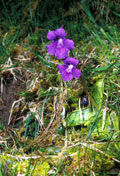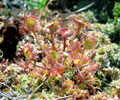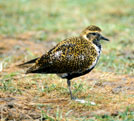 |
Bogs are made up of a dark, wet soil known as peat. |
 |
Peat is composed of 90% water and 10% solid material. |
 |
This peat is formed by layers of partially rotted plants which have built up slowly over thousands of years. |
 |
Almost all the water which supplies bogs comes from rainfall. As a result bogs are very low in nutrients (plant and animal food). |
| |
 |
| |
Greater Butterwort |
|
 |
In most bog areas the peat soil is between 2 and 6 metres in depth, however in some places peat can be more than 12 metres deep. |
 |
In order for a bog to keep growing the water level in the peat must be kept close to the surface for most of the year. |
 |
The plant species which grow on bogs are especially adapted to wet, nutrient-poor conditions. Common plant species include cross-leaved heather, deer grass, bog cotton, white-beaked sedge and Sphagnum moss. |
 |
Bogs contain three types of plants which trap and digest insects, namely sundews, butterworts and bladderworts. Sundews and butterworts trap insects on sticky leaf surfaces while bladderworts live in water and trap swimming insects in small, air-filled bladders |
| |
 |
| |
Sundews |
|
 |
In order to conserve food from year to year many bog plants such as purple moor grass and bog cottons transfer food from the leaves to the roots just before the leaves die back and fall off in winter. This ensures that they have plenty of food to grow quickly again the following spring. |
 |
One of the most important plant species of the bog is Sphagnum moss. The species makes bog water more acid by taking in nutrients such as calcium and replacing them with hydrogen which acidifies the water. Sphagnum moss is the main component of peat in raised bogs. |
| |
 |
| |
Sphagnum Moss |
|
 |
Throughout the world bogs are rare and Ireland contains some of the best examples of bog habitat in the world. |
 |
Two types of bog occur in Ireland, blanket bogs and raised bogs. Blanket bogs are more common in the wetter west of the country while raised bogs occur in the midlands. Blanket bogs generally cover large areas and the peat is quite shallow while raised bogs are smaller in area and usually have a deep peat cover. |
 |
Irish bogs are home to a number of rare plant and animal species. Rare animals include the otter and birds of prey such as hen harrier and merlin. Examples of rare plants include marsh saxifrage, slender bog cotton and shining sicklemoss. Many of these species are also rare elsewhere in Europe. |
 |
Most of the peatland area in Ireland (c. 85%) has been lost due to activities such as peat-cutting, afforestation and reclamation for agriculture. |
 |
Today most of the best examples of bog in Ireland are protected from development by law and efforts are being made to restore some areas which have been damaged in the past. |
| |
 |
| |
Golden Plover |
|
 |
The main way to restore a damaged bog is to block any drains on its surface. This raises the watertable in the peat close to the surface and helps the bog to start growing again. |
| |
|
|


